Key takeaways:
- Understanding portion control improves diet balance and enhances the relationship with food by focusing on serving sizes.
- Practicing mindful eating and portion management can lead to better energy levels and satisfaction without overindulging.
- Implementing techniques like using smaller plates, measuring food, and planning meals allow for effective portion control.
- Visual presentation and recipe adjustments, such as mini portions and colorful ingredients, can enhance meal enjoyment and awareness.
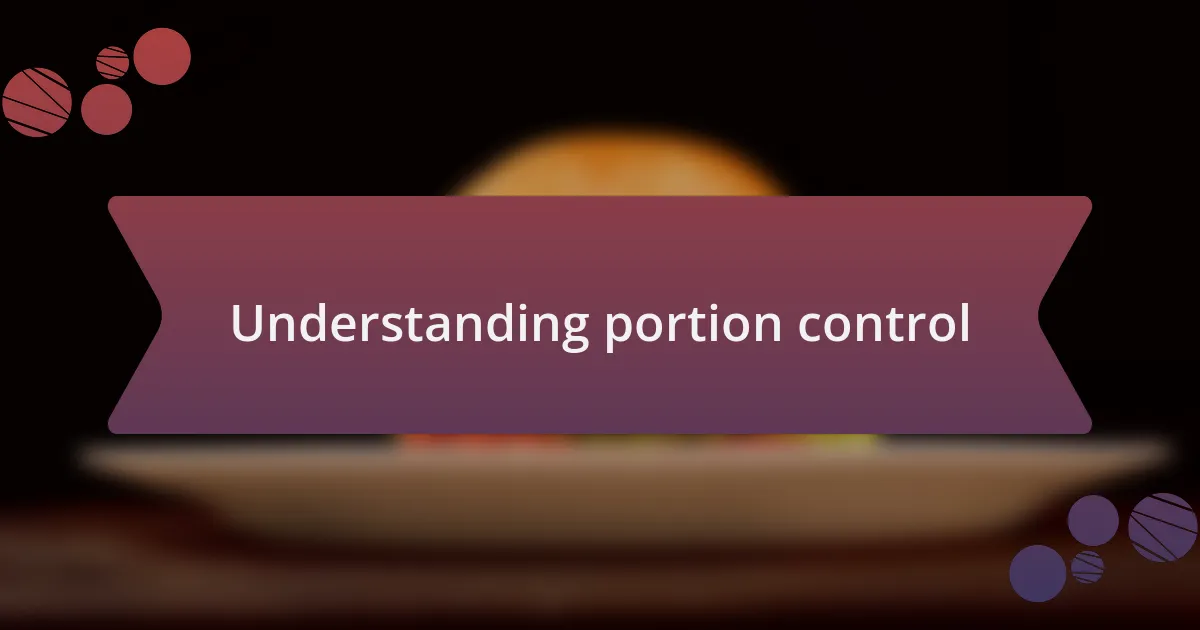
Understanding portion control
Understanding portion control is crucial for maintaining a balanced diet and enjoying our meals without overindulging. I remember the first time I tried to manage my portions; I was amazed at how just a few adjustments helped me feel satisfied without that bloated feeling afterward. The experience taught me that awareness of serving sizes can truly enhance our relationship with food.
Have you ever looked down at your plate and wondered why it felt like a mountain of food? I often found myself loading my plate more out of habit than hunger. By practicing portion control, I discovered the importance of listening to my body’s actual hunger signals instead of allowing external factors to dictate my serving sizes.
When I started using smaller plates, it was a game changer. It felt like magic—my mind was tricked into thinking I was eating more! This simple shift not only improved my portion awareness but also made meals more enjoyable, allowing me to appreciate every bite without guilt. Understanding portion control is less about restriction and more about finding balance in what we eat.
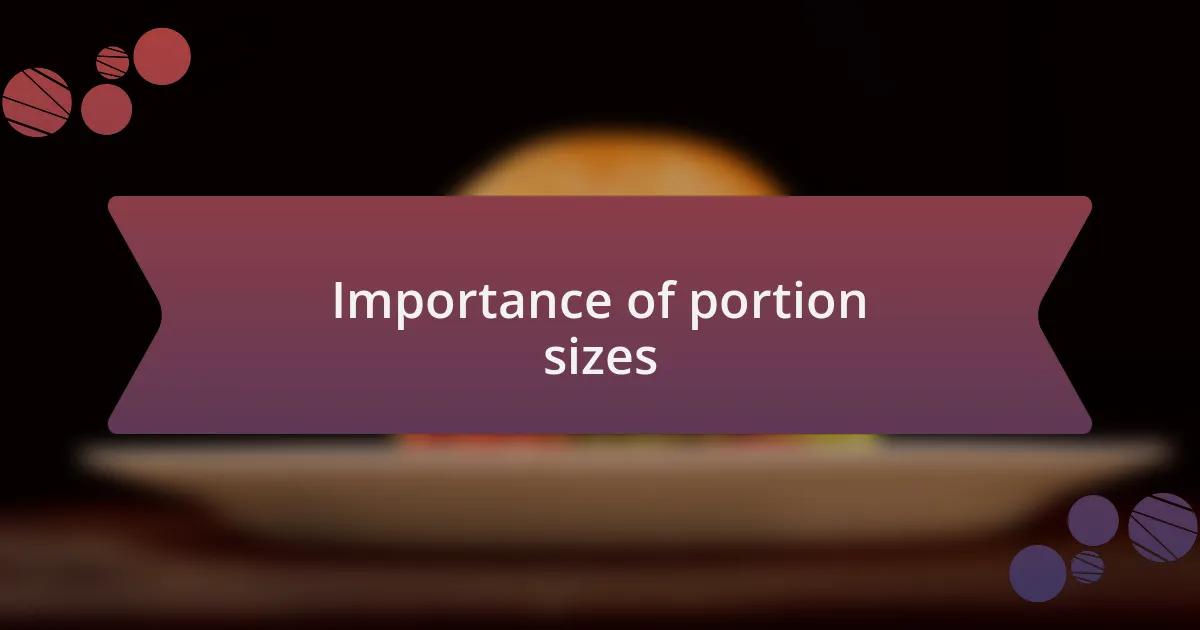
Importance of portion sizes
These small adjustments in portion sizes can have a significant impact on our overall health. I remember a time when I referred to oversized servings as “normal.” It wasn’t until I started measuring my portions that I realized how much my perception of a healthy plate had been skewed. This revelation helped me understand that the right portion can lead to better energy levels and improved digestion.
As I became more educated about portion sizes, I began to notice how they influenced my eating habits. I often asked myself, “Am I really hungry, or is this just a habit?” This reflection allowed me to tune in to my body’s signals, leading to a more intuitive approach to eating. A perfect example was when I switched to evaluating my plates before serving; I found that smaller portions of my favorite dishes made me relish the experience rather than mindlessly consume.
I’ve found that mindful eating encourages a sense of satisfaction that larger portions sometimes fail to provide. One evening, I decided to serve myself a smaller portion of pasta, and to my surprise, I found the dish just as fulfilling. It was a reminder that it’s not about the quantity but the quality of our meals. Such experiences reaffirmed my belief that understanding and respecting portion sizes can transform how we engage with food on a profound level.
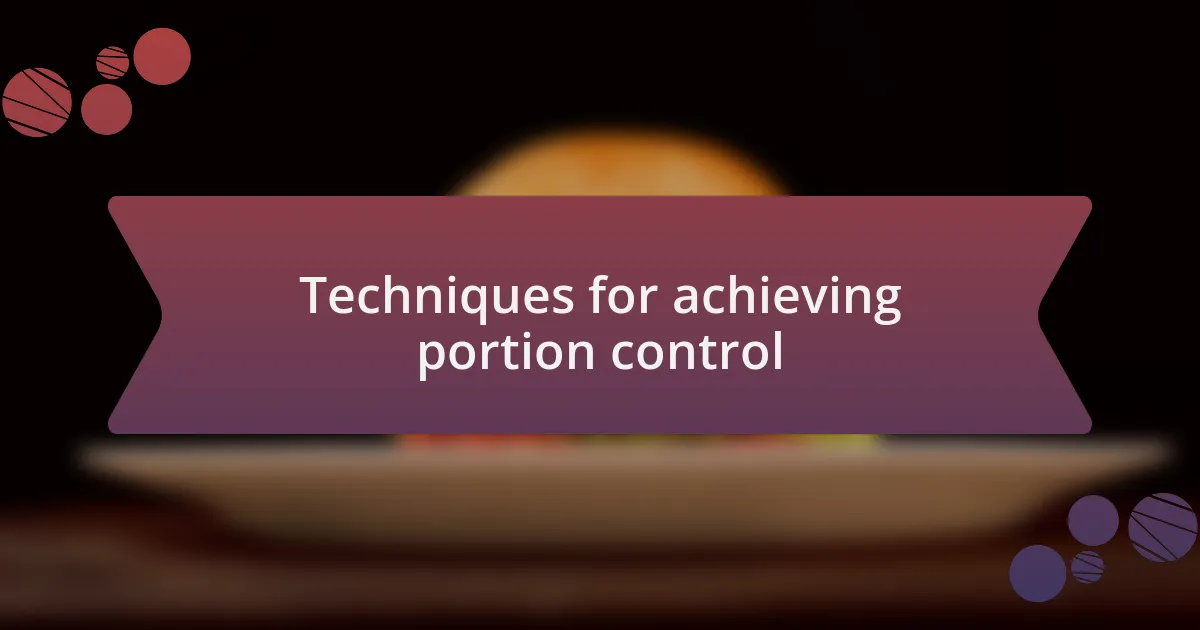
Techniques for achieving portion control
There are several practical techniques I use to achieve portion control effectively. One method that works for me is using smaller plates and bowls. When I switched to a smaller dinner plate, I found that it tricked my mind into believing I was enjoying a fuller meal, even when the portion sizes were reduced. Have you ever tried this? It really changes the way you perceive your meal.
Measuring food is another strategy I adopted. Initially, I would feel a bit silly weighing my portions, but I quickly learned the value in precision. For example, when I started measuring my cereal in the morning, I noticed I was consuming significantly less than I thought. I remember feeling surprised at how just a half-cup made my breakfast still satisfying while actually helping me cut down on unnecessary calories.
Lastly, I often practice the “half-my-plate” rule, where I fill half my plate with vegetables before adding other items. It’s a simple way to bulk up my meals with nutrition while naturally controlling the overall amount. One day, I paired roasted veggies with my favorite protein, and the colorful display made me excited to eat. It taught me that portion control can also enhance my meals visually and nutritionally. Have you explored how a colorful plate can make you feel more satisfied?
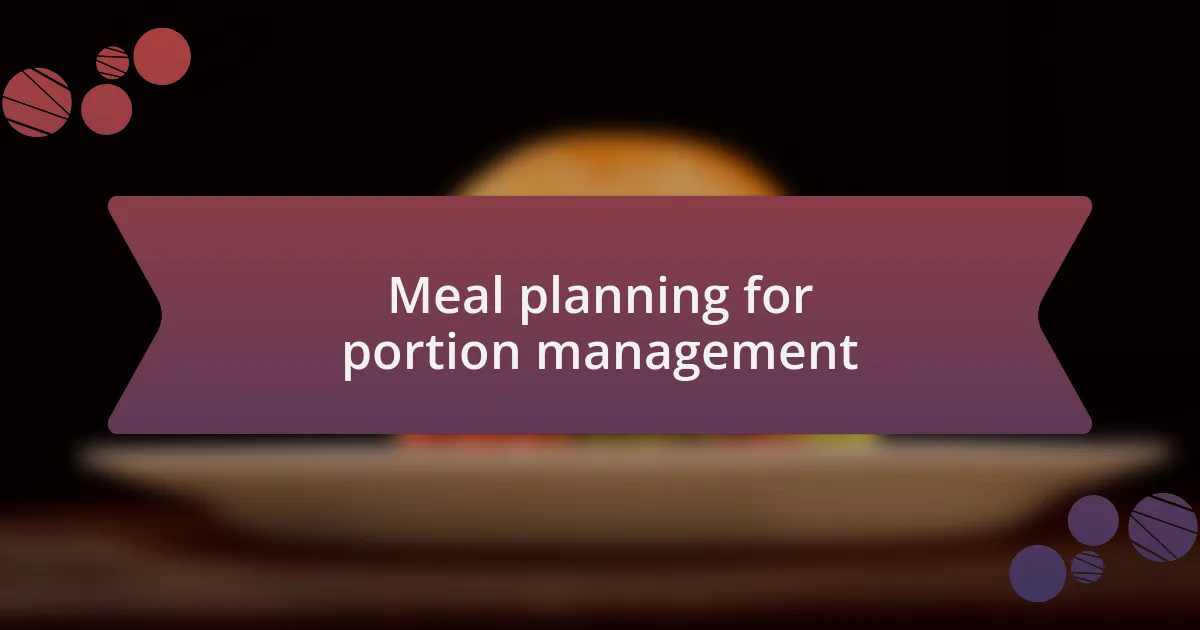
Meal planning for portion management
Meal planning is a game changer when it comes to managing portions. I often spend a little time each week organizing my meals, which ensures that I not only have balanced options but also appropriate portion sizes. For instance, I remember a week when I prepped grilled chicken with quinoa and steamed broccoli. Dividing these into containers helped me understand exactly how much I was eating versus what I thought I was eating. Has meal prep ever made you feel more in control?
When planning, I write down not just the meals but also their portion sizes. One particular Friday, I decided to portion out my favorite chili into individual servings. It was comforting to know that I could just grab a container without worrying about overeating. And guess what? It turned out to be a great conversation starter for my friends, who were curious about my planning method. How often do you find yourself reaching for extra servings when meals aren’t pre-portioned?
I also love integrating variety into my meal plans, allowing me to control portions while keeping meals exciting. Each Sunday, I try to mix things up by choosing different proteins and grains, so I don’t fall into a monotonous routine. Recently, I experimented with making black bean tacos one week, and the next, I tried salmon with brown rice. So, while I’m managing my portions, I’m also enjoying a culinary adventure. What’s your favorite way to keep your meals diverse?
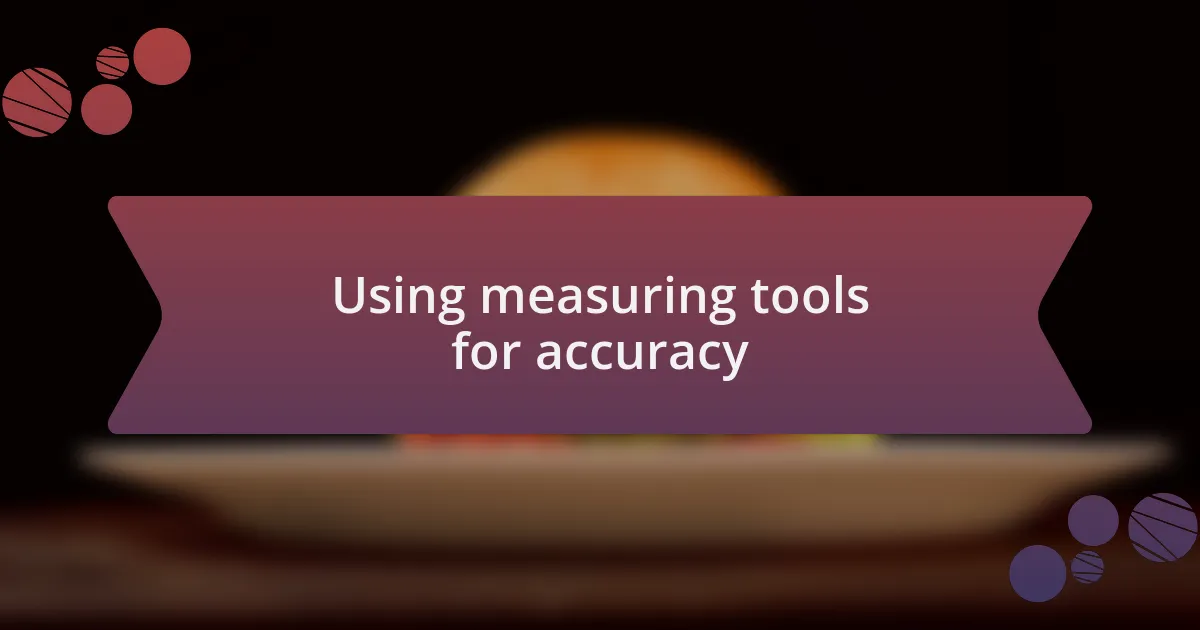
Using measuring tools for accuracy
Using measuring tools can significantly enhance your portion control game. I once invested in a set of measuring cups and spoons, which seemed tedious at first, but the accuracy they provide is unmatched. I vividly remember cooking oatmeal for breakfast. With the right measurements, I found I enjoyed my food more because I had exactly what I needed – no extra, no guesswork.
At times, I even use a food scale, especially when trying to portion out proteins. It was eye-opening to see that a typical chicken breast I thought was a single serving was actually two! This realization not only helped me manage my calorie intake but also made me become more mindful about what I put on my plate. Have you ever measured something and felt surprised by the actual amount?
Incorporating these tools into my cooking routine made the entire process more enjoyable. For example, while baking, using a digital scale for flour transformed my cookies. They turned out consistent every time, eliminating the guesswork that often led to disappointment. Doesn’t it feel great when a simple tool elevates your cooking experience?

Personal experiences with portion control
When I first started focusing on portion control, it felt like an uphill battle. I distinctly remember hosting a dinner party where I prepared what I thought was the perfect amount of pasta. By the end of the night, I realized I had overcooked enough to feed a small army! The leftovers loomed in my fridge for days, reminding me that managing portions isn’t just about individual meals but also about avoiding food waste. Have you ever cooked too much and felt that pang of regret?
As I became more adept at portioning, I found that it significantly altered my relationship with food. One night, while preparing a stir-fry, I decided to consciously measure my vegetables. The colors on my plate were vibrant, and instead of feeling stuffed, I savored each bite, enjoying the flavors rather than just eating for the sake of it. It felt liberating to realize that eating less didn’t mean depriving myself; it actually enhanced my enjoyment.
I also learned that visual cues could help with portion control. For instance, I began plating my meals on smaller dishes. This simple change tricked my mind into thinking I had a fuller plate. Recently, I served a salad in a small bowl and relished the vibrant mix of greens and toppings, feeling satisfied without the urge to go back for more. It’s funny how our perceptions can shift with a few tweaks in our routine, don’t you think?
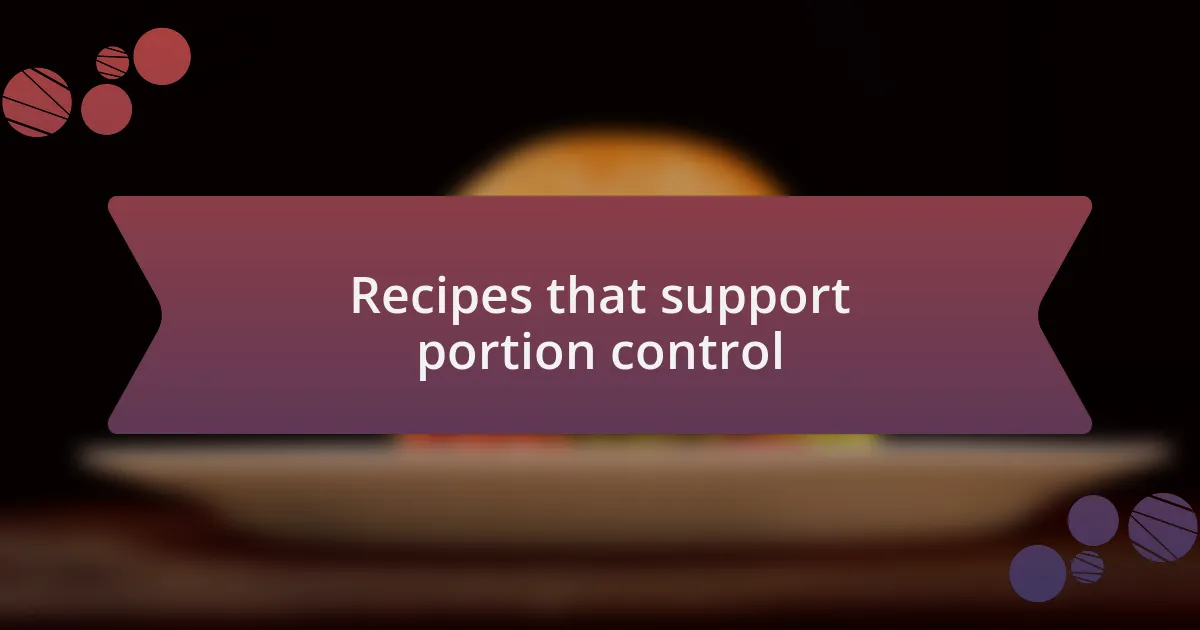
Recipes that support portion control
Recipes that support portion control can make all the difference in how we view our meals. For instance, I recently tried making mini quiches in muffin tins, which not only provided a perfectly portioned bite but also allowed me to experiment with different fillings. Each mini quiche felt like a treat, and I noticed that by savoring smaller portions, I truly enjoyed the flavors rather than just filling up.
Another recipe that has become a staple in my home is a vegetable-packed grain bowl. I start with a base of quinoa or brown rice and layer it with a variety of colorful vegetables and a small serving of protein. When I present each ingredient separately, I find myself more mindful about what I’m eating. Have you ever noticed how seeing a well-arranged bowl makes you appreciate the meal more? It’s a simple yet effective way to manage portion sizes while enjoying a diverse range of nutrients.
Finally, one of my favorite desserts that encourages portion control is a fruit parfait. By layering Greek yogurt, a handful of fresh berries, and a sprinkle of granola in a small glass, I satisfy my sweet tooth without overindulging. The visual appeal of the layers enhances my eating experience, making even a small portion feel indulgent and delightful. How often do we find joy in the simple act of presentation? It’s incredible how a few mindful choices can transform our meals and our approach to portion control.